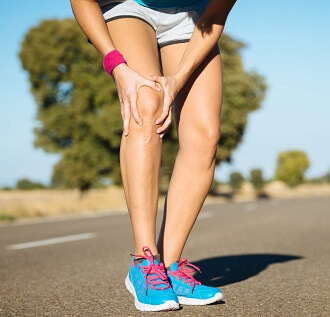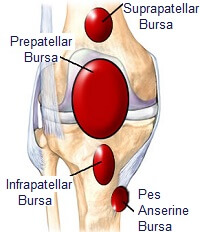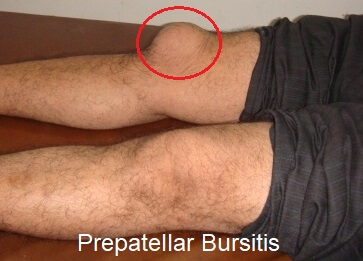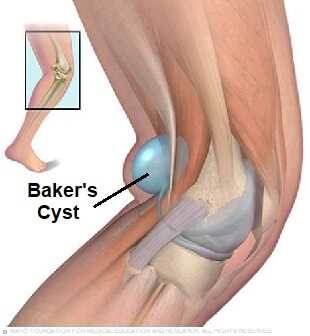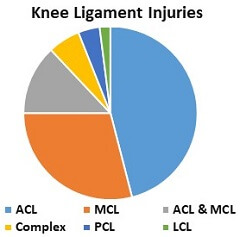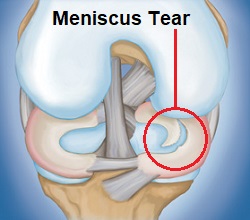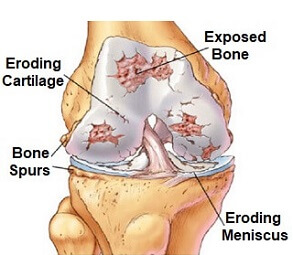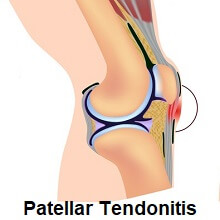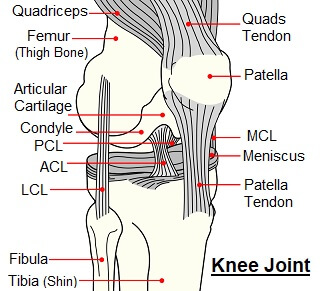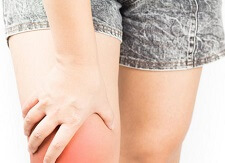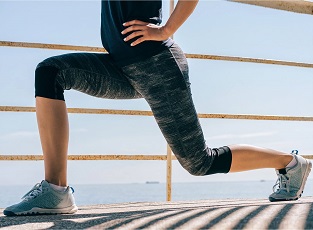- Home
- Knee Symptoms
- Knee Pain Bending
Knee Pain When Bending
Written By: Chloe Wilson, BSc(Hons) Physiotherapy
Reviewed by: KPE Medical Review Board
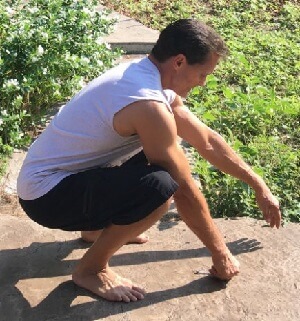
Knee pain when bending is a common problem. Forces up to seven times body weight can go through the knee as it bends, so it comes as no surprise that it is such a widespread problem.
Bending knee pain may start suddenly after an injury, or gradually come on over time depending on the cause.
There are a number of different causes of knee pain when bending, but they generally all result from a problem with one (or more) of the structures in or around the knee, affecting how it moves.
This changes how the forces travel through the different parts of the knee and can result in too much pressure going through certain parts, which leads to knee pain bending.
Here we will look at the different types of bending knee pain, the most common causes of knee pain when bending, treatment options and what is actually going on in the knee as it bends.
Why Does Bending Cause Knee Pain?
Knee pain when bending can be split into two types:
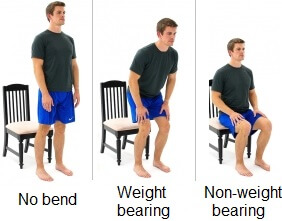
Weight-Bearing: when there is weight going through the knee as you bend it such as when you squat down, go up and down stairs and as you sit down in a chair
Non Weight-Bearing: when there is no weight going through the knee when you bend it e.g. when sitting in a chair and moving the knee or standing but with the leg lifted off the floor as you bend it
Knee pain when bending tends to be worse when there is weight going through the knee as you bend it due to the compression and pressure on the different structures in the knee.
This should come as no surprise when we realise how large the forces going through different parts of the knee.
For example, when bending the knee to climb stairs, a force approximately three times body weight goes through the knee.
When squatting down the force is even greater at seven times body weight and when jumping, a huge force ten times body weight goes through part of the knee.
Causes Of Knee Pain When Bending
So let’s look at the most common causes of knee pain when bending and how to treat them:
1. Runners Knee
Runners Knee is the most common cause of knee pain when bending but don’t be fooled by the name. It is just as likely to affect office workers as runners! Runners Knee is also, more accurately, know as anterior knee pain or patellofemoral pain syndrome.
What Is It: Runners Knee is a problem with how the knee cap moves places extra stress and friction on the cartilage as the knee bends and straightens
Causes: Muscle weakness and/or tightness or altered biomechanics such as foot arches and hip angle
Symptoms: Knee pain when bending the knee is the most common symptom and tends to be at the front of the knee, just below and to the sides of the kneecap. It may occur during bending activities such as squatting or coming down stairs, or when you first move the knee after sitting down for prolonged periods e.g. driving or watching TV. Another common feature is a grinding or grating sound as you bend and straighten the knee.
Onset: Symptoms develop gradually
Find out more about the causes, symptoms, diagnosis, prevention & treatment options: Runners Knee
2. Knee Bursitis
Knee bursitis is another common cause of swelling and knee pain when bending. Bursa are small, fluid-filled sacs that site between bone and soft tissues to reduce friction.
What Is It: Bursitis is inflammation of one or more of the bursa located around the knee
Causes: Prolonged/repetitive pressure, excessive friction, a fall or blow to the knee
Symptoms: Knee pain bending - the location will depend on which bursa is affected
Onset: in most cases a gradual onset of knee pain but can develop suddenly after an injury
Find out more about the causes, symptoms, diagnosis, prevention & treatment options: Knee Bursitis
3. Housemaids Knee
Housemaids knee is a common cause of swelling and knee pain when bending in people who spend a lot of time kneeling.
What Is It: Housemaids Knee is inflammation on the prepatellar bursa found just below the kneecap at the front of the knee
Causes: Prolonged/repetitive kneeling e.g. housework or tradesmen work, a blow to the knee e.g. falling onto the knee
Symptoms: front knee pain when bending and straightening the knee, swelling at the front of the knee
Onset: usually gradual unless there was a direct force through the knee
Find out more about the causes, symptoms, diagnosis, prevention & treatment options: Housemaids Knee
4. Bakers Cyst
A bakers cyst is the most common cause of swelling behind the knee and posterior knee pain when bending.
What Is It: A Bakers Cyst is swelling of the semimembranosus bursa at the back of the knee
Causes: Excess fluid in the knee joint seeps back into the bursa and collects resulting in swelling. Usually caused by arthritis but can develop with any condition that causes swelling in the knee joint e.g. a cartilage tear or gout
Symptoms: Stiffness and knee pain when bending and straightening the knee, worse with activity and better with rest. People can often feel a small bulge at the back of their knee that feels like a water balloon
Onset: Bending knee pain symptoms develop gradually
Find out more about the causes, symptoms, diagnosis, prevention & treatment options: Bakers Cyst
5. Knee Sprain
Knee sprains can cause knee pain when bending due to instability. The knee has four ligaments that help control the stability of the knee. The cruciate ligaments sit inside the joint and the collateral ligaments are found either side of the knee
What Is It: A knee sprain is when one of the knee ligaments gets overstretched and tears. There are three different grades of knee sprain depending on how much of the ligament is damaged
Causes: Excessive force through the knee or sudden twisting or the knee
Symptoms: Pain with activity and difficulty bending and straightening the knee. Instability of the knee and swelling. The more severe the injury, the more severe the symptoms
Onset: Immediate or within a couple of days of the injury
Find out more about the causes, symptoms, diagnosis, prevention & treatment options: Knee Sprains
6. Meniscus Tear
Meniscus tears are a common cause of knee pain when bending. The meniscus is a special, extra thick layer of cartilage that lines the knee joint to provide cushioning and protection to the knee. It also helps to transmit the forces through the knee correctly.
What Is It: A meniscus tear is when there is tearing or fraying in the meniscus results in inflammation, and decreased cushioning of the joint. Sometimes the torn fragment gets stuck in the joint limiting movement
Causes: Wear and tear or sudden twisting of the knee when the foot is fixed
Symptoms: Knee pain when bending especially going up stairs or squatting down. Knee movement may be limited and in some cases the knee gets stuck when the loose fragment gets locked in the joint. The knee will most likely be swollen
Onset: May develop gradually from wear and tear or suddenly after an injury such as twisting the knee when the foot is fixed
Find out more about the causes, symptoms, diagnosis, prevention & treatment options: Meniscus Tears
7. Knee Arthritis
One of the most common causes of knee pain when bending over the age of 60 is knee arthritis. Arthritis means “inflammation of a joint” and affects millions of people worldwide. There are over 200 different types of arthritis, but the one that most commonly causes knee pain when bending is osteoarthritis.
What Is It: Osteoarthritis is where there is thinning and wear and tear of the cartilage lining the knee joint, and the formation of bony lumps in the joint. These result in excessive friction through the knee bones
Causes: There are a multitude of causes of arthritis including previous damage to the knee, genetics, being over-weight and altered biomechanics changing the way the forces travel through the knee
Symptoms: Knee pain, particularly first thing in the morning or after prolonged sitting when you then try and bend your knee. There is often so much knee pain when bending or straightening your knee fully that the joint starts to stiffen. The pain tends to ease with gentle movement but gets worse if you do too much, especially on a bent knee such as stairs or bending down
Onset: Symptoms develop gradually over time and often come and go. Osteoarthritis most commonly affects people over the age of 65
Find out more about the causes, symptoms, diagnosis, prevention & treatment options: Knee Arthritis
Other Causes of Knee Pain When Bending
Other less common causes of knee pain when bending include:
- Patellar Tendonitis: Inflammation and micro-tears in the patellar tendon just below the kneecap, usually after prolonged jumping or kicking movements resulting in bending knee pain. The most defining feature of patellar tendonitis is that it is painful if you press on the tendon
- Iliotibial Band Syndrome (ITBS): Irritation and inflammation of a thick fibrous band on the outer side of the thigh and knee. It usually develops from overuse and most frequently affects runners. Sending bending knee pain from ITBS tends to be on the outer side of the knee and there may be a popping/grinding sensation as you bend the knee
- Osgood Schlatters: A common cause of bending knee pain in teenagers usually associated with sudden growth spurts where the bones grow quicker than the soft tissues leading to excessive tension through the patellar tendon which damages the underlying bone.
- Hamstring Tendonitis: Irritation and inflammation in one of the hamstring tendons at the back of the knee. It is an overuse injury from repetitive sporting activities such as running, jumping, kicking or cycling. The posterior knee pain when bending from hamstring tendonitis generally gets better with rest and worse with activity.
Treating Knee Pain When Bending
The best treatment for knee pain when bending will depend on the underlying cause of your knee pain. In most cases it will involve:
You will find loads more information on the different conditions we have looked at including the best ways to treat knee pain when bending by using the links above.
Here we have looked at the most common causes of knee pain when bending, but almost any problem with the knee can result in pain as you move it. If none of these is sounding quite right, visit the knee pain diagnosis section for more help work out what is causing your bending knee pain.
How Does The Knee Bend?
The knee is a hinge joint, which means its main movement is bending and straightening (aka flexion and extension). As the knee moves, a number of things are happening:
Muscles: They work in pairs with one relaxing and the other contracting (tightening) to allow the movement e.g. to bend your knee you hamstrings contract and you quads relax
Bones: The femur (thigh) and tibia (shin) have to roll, glide and spin to move smoothly. The patella (kneecap) shifts, tilts and rotates as it glides up and down through a groove on the thigh bone – the position and movement of the patella is controlled by the surrounding muscle.
Cartilage: The special shock-absorbing cartilage that lines the knee (known as the meniscus) moves and changes shape slightly to prevent it from getting trapped
Ligaments: These help control the movement and maintain stability by preventing excessive movement of the bones. There are two pairs of ligaments, the cruciate ligaments in the middle of the joint, and the collateral ligaments on either side
These structures all need to work together properly to allow for smooth, pain-free knee bending and straightening. Problems in any of these areas can lead to knee pain when bending. For example, if there is muscle weakness or ligament instability, the bones may move slightly out of position causing them to catch or grind on other structures in the knee.
Knee Pain When Bending Summary
Knee pain when bending is a common problem, often caused by overloading or incorrect movement at the knee.
Forces up to seven times body weight go through the knee as it bends.
If the forces aren't directed evenly through the joint as the knee bends, it can cause friction or excessive force through the knee.
Knee pain bending is often due to damage and inflammation in the knee cartilage, bursa and ligaments.
Treatment will depend on the underlying cause of the knee pain but may include a combination of PRICE, exercises, knee braces, injections and in some cases, surgery.
You may also be interested in the following articles:
- Front Knee Pain
- Pain Above The Knee
- Pain Behind The Knee
- Pain Below The Knee
- Inner Knee Pain
- How To Do Stairs With Knee Pain
- Knee Swelling
Page Last Updated: 20/06/23
Next Review Due: 20/06/25
